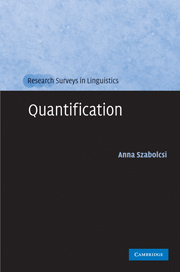Book contents
- Frontmatter
- Contents
- List of figures
- List of tables
- Acknowledgements
- 1 What this book is about and how to use it
- 2 Generalized quantifiers and their elements: operators and their scopes
- 3 Generalized quantifiers in non-nominal domains
- 4 Some empirically significant properties of quantifiers and determiners
- 5 Potential challenges for generalized quantifiers
- 6 Scope is not uniform and not a primitive
- 7 Existential scope versus distributive scope
- 8 Distributivity and scope
- 9 Bare numeral indefinites
- 10 Modified numerals
- 11 Clause-internal scopal diversity
- 12 Towards a compositional semantics of quantifier words
- Notes
- Bibliography
- Index
10 - Modified numerals
Published online by Cambridge University Press: 05 June 2012
- Frontmatter
- Contents
- List of figures
- List of tables
- Acknowledgements
- 1 What this book is about and how to use it
- 2 Generalized quantifiers and their elements: operators and their scopes
- 3 Generalized quantifiers in non-nominal domains
- 4 Some empirically significant properties of quantifiers and determiners
- 5 Potential challenges for generalized quantifiers
- 6 Scope is not uniform and not a primitive
- 7 Existential scope versus distributive scope
- 8 Distributivity and scope
- 9 Bare numeral indefinites
- 10 Modified numerals
- 11 Clause-internal scopal diversity
- 12 Towards a compositional semantics of quantifier words
- Notes
- Bibliography
- Index
Summary
The treatment of unmodified indefinites and universals has undergone major revisions in recent decades, but the original generalized-quantifiertheoretic analysis of modified numeral expressions took the brunt of the criticism, as seen in Chapter 5. The present chapter looks at some interesting properties of modified numerals in their own right. These are the absence of scalar (‘exactly’) implicatures; the question whether comparative (more than) and superlative (at least) modifiers yield interchangeable expressions; the interaction of comparative determiners with modals; and the compositional interpretation of amount-superlatives ((the) most NP). After this we attempt a preliminary characterization of a class of items that have been dubbed counting quantifiers. The next chapter will return to modified numerals with a discussion of their scope behavior.
The absence of scalar implicatures in modified numerals
The unmodified numeral expressions discussed in the previous chapter were associated with a scalar implicature that stronger alternatives on the Horn-scale are false. But modified numeral expressions do not carry such an implicature. The interpretations given below are incoherent or are unfaithful to the sentence, depending on what one thinks the numbers greater than at least three might be. Parallel observations hold for at most four boys and fewer than four boys.
(1) At least three boys left.
#‘At least three boys left and it is false of all numbers n greater than at least three that n boys left’
(2) More than three boys left.
#‘More than three boys left and it is false of all numbers n greater than at least three that n boys left’
Information
- Type
- Chapter
- Information
- Quantification , pp. 161 - 176Publisher: Cambridge University PressPrint publication year: 2010
